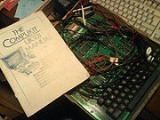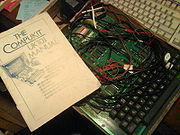
Compukit UK101
Encyclopedia
The Compukit UK101 microcomputer
(1979) was a kit clone of the Ohio Scientific
Superboard II single-board computer
, with a few enhancements for the UK market - notably replacing the 24×24 (add guardband kit to give 32×32) screen display with a more useful 48×16 layout working at UK video frequencies. The video output was black and white with 256 characters generated by a two kilobyte
ROM
. It had no bit-mapped graphics capability.
The video was output through a UHF modulator, designed to connect to a TV set.
 It was powered by a 6502 microprocessor CPU running at 1 MHz, and was equipped with up to 8 kilobytes of RAM using 2114 static RAM chips of 1024×4-bit. An additional memory-mapped 1 KB of RAM was used for the video display. It had the 8K Microsoft BASIC
It was powered by a 6502 microprocessor CPU running at 1 MHz, and was equipped with up to 8 kilobytes of RAM using 2114 static RAM chips of 1024×4-bit. An additional memory-mapped 1 KB of RAM was used for the video display. It had the 8K Microsoft BASIC
interpreter stored in ROM
. In addition to Basic, a 6502 machine code monitor (2Kb) was built into ROM. It allowed programming by entering sequences of 6502 operational codes. Later a two pass assembler was available which allowed the use of assembly language.
In common with other home computers of the time, software could be saved and loaded on standard cassette tapes. The UK101 uses the Kansas City standard
tape format. I/O was managed by a Motorola 6850 ACIA. This allowed a full RS232 port to be implemented, with the addition of a few extra components and minor modifications to existing jumpers on the board.
The 40 pin expansion socket opened up the world to the UK101. One could attach a dual floppy disk controller (5.25") and a memory expansion card (40K max) to allow faster and reliable save/load of programs/data.
A sound card became available, built around the General Instruments AY-3-8910 , which together with a peripheral interface Adaptor (PIA) chip - 6521, gave the UK101 VOICE.
The UK101 design was published in Practical Electronics, a popular hobbyists magazine at the time.
Kits of parts for building the machine were available from Comp Shop Ltd of Station Road, New Barnet (North London).
Microcomputer
A microcomputer is a computer with a microprocessor as its central processing unit. They are physically small compared to mainframe and minicomputers...
(1979) was a kit clone of the Ohio Scientific
Ohio Scientific
Ohio Scientific Inc. was a United States computer company that built and marketed computers from the late 1970s to the early 1980s...
Superboard II single-board computer
Single-board computer
A single-board computer is a complete computer built on a single circuit board, with microprocessor, memory, input/output and other features required of a functional computer. Unlike a typical personal computer, an SBC may not include slots into which accessory cards may be plugged...
, with a few enhancements for the UK market - notably replacing the 24×24 (add guardband kit to give 32×32) screen display with a more useful 48×16 layout working at UK video frequencies. The video output was black and white with 256 characters generated by a two kilobyte
Kilobyte
The kilobyte is a multiple of the unit byte for digital information. Although the prefix kilo- means 1000, the term kilobyte and symbol KB have historically been used to refer to either 1024 bytes or 1000 bytes, dependent upon context, in the fields of computer science and information...
ROM
Rom
ROM, Rom, or rom is an abbreviation and name that may refer to:-In computers and mathematics:* Read-only memory, a type of storage media which is used in computers and other electronic devices....
. It had no bit-mapped graphics capability.
The video was output through a UHF modulator, designed to connect to a TV set.

Microsoft BASIC
Microsoft BASIC was the foundation product of the Microsoft company. It first appeared in 1975 as Altair BASIC, which was the first BASIC, and the first high level programming language available for the MITS Altair 8800 hobbyist microcomputer....
interpreter stored in ROM
Read-only memory
Read-only memory is a class of storage medium used in computers and other electronic devices. Data stored in ROM cannot be modified, or can be modified only slowly or with difficulty, so it is mainly used to distribute firmware .In its strictest sense, ROM refers only...
. In addition to Basic, a 6502 machine code monitor (2Kb) was built into ROM. It allowed programming by entering sequences of 6502 operational codes. Later a two pass assembler was available which allowed the use of assembly language.
In common with other home computers of the time, software could be saved and loaded on standard cassette tapes. The UK101 uses the Kansas City standard
Kansas City standard
The Kansas City Standard , or Byte standard, is a digital data format for audio cassette drives. Byte magazine sponsored a symposium in November 1975 in Kansas City, Missouri to develop a standard for storage of digital computer data on inexpensive consumer quality cassettes, at a time when...
tape format. I/O was managed by a Motorola 6850 ACIA. This allowed a full RS232 port to be implemented, with the addition of a few extra components and minor modifications to existing jumpers on the board.
The 40 pin expansion socket opened up the world to the UK101. One could attach a dual floppy disk controller (5.25") and a memory expansion card (40K max) to allow faster and reliable save/load of programs/data.
A sound card became available, built around the General Instruments AY-3-8910 , which together with a peripheral interface Adaptor (PIA) chip - 6521, gave the UK101 VOICE.
The UK101 design was published in Practical Electronics, a popular hobbyists magazine at the time.
Kits of parts for building the machine were available from Comp Shop Ltd of Station Road, New Barnet (North London).

